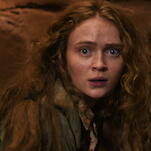Doctor Who (Classic): “Remembrance Of The Daleks”

“Remembrance Of The Daleks” (season 25, episodes 1-4. Originally aired Oct. 5-26, 1988)
Even when a TV series has a plot device like time travel—perhaps especially when a TV series has a plot device like time travel—it’s awfully dangerous to go messing around with the established history that helps create its central premise, particularly when the show has built up 25 seasons’ worth of continuity baggage in the interim. So the sheer audacity of what “Remembrance Of The Daleks” tries to do by revisiting the time and place of the Doctor’s earliest-known adventure is little short of breathtaking once you realize what the writers are up to: Redefining the reason why the Doctor fled his home planet all those years ago, and thus implicitly suggesting that he’s never quite been the person we thought he was.
That’s the kind of thing that can completely wreck a series from within, and it’s a credit to writer Ben Aaronovich and script editor Andrew Cartmel that the gamble works as well as it does. Whether it was a good idea to have tried in the first place is, I think, debatable. But let’s come back to that later; there’s a lot happening in “Remembrance Of The Daleks,” and I shouldn’t jump too far ahead.
First, a little bit about where we are in the series right now: “Remembrance” kicks off season 25, the second year of Sylvester McCoy’s run as the Seventh Doctor, which began in the aftermath of the utterly disastrous “Trial Of A Time Lord” arc two years earlier when both script editor Eric Saward and star Colin Baker had both abruptly left or been forced out, ending Doctor Who’s most unwatchable era. Producer John Nathan-Turner (who somewhat surprisingly still had his job) brought in McCoy and a new script editor, Andrew Cartmel, to rejuvenate the series and find some new, more palatable direction. And although McCoy’s introduction, “Time And The Rani,” was unpromisingly silly and vapid, Doctor Who did improve, though it took the show the better part of the next season to find its feet. Ratings were still way down, and Doctor Who would wind up cancelled two years later anyway—but on the whole, the final two seasons were smarter, better-written, and more full of ambitious ideas than Doctor Who had been in years. They weren’t always able to actually achieve those high ambitions, hampered by Cartmel’s inexperience and the show’s low budget, but even the failures here are more compelling than the best stuff from the years immediately prior.
That started by refurbishing the Doctor himself. Though “Time And The Rani” gave a first impression that the Seventh Doctor was a foolish clown who’d be just as likely to win by dumb luck as skill, Cartmel and McCoy found deeper layers to the character. Cartmel jettisoned Saward’s strange insistence on an incompetent main character, and gave the Seventh Doctor a manipulative streak and a penchant for long-term strategic thinking worthy of a chess grandmaster, not to mention hints that he might be far older, more powerful, and mythic than he’d ever let on. McCoy deftly incorporated that into his performance by giving his character a seriousness and intelligence that clearly drove his actions, but which could easily be missed if you only paid attention to his surface eccentricities, and which would often cause his enemies to badly underestimate him—the tactic of Peter Falk’s Columbo and, of course, Patrick Troughton’s Second Doctor. And like those characters, the Seventh Doctor was funny and likeable in a sort of Chaplinesque, perennial-underdog way, something Doctor Who badly needed to return to.
Which is not to say I’m an unabashed fan of this period. Season 26’s “The Curse Of Fenric,” for instance, is often hailed by McCoy partisans as one of the best Doctor Who stories ever made, but I find it sloppy and unfocused. And in general, this era hasn’t aged well to me on a visual level. The 1980s-ness of the synth-heavy soundtrack, the costumes, and the special effects often seem dated enough to take me out of the story entirely, and the opening credits in particular look embarrassingly like a first-year graphic-design student’s “Intro To TV Production” final project. True, you do have to learn to accept B-movie ricketiness to any era of Doctor Who if you’re going to enjoy the show at all, but 1980s Doctor Who has always struck me as tackier and uglier than older seasons in a way that's less easy to forgive. Nevertheless, Cartmel and McCoy proved that Doctor Who still had creative life in it after the near-apocalypse of the Sixth Doctor seasons, and in many ways the spirit of their era provided greater inspiration than any other pre-cancellation production team for how the current series approaches Doctor Who.
And “Remembrance Of The Daleks” is the Seventh Doctor era at its best. Appropriately for the kickoff to the show’s silver-anniversary season, it weaves together a nostalgia-heavy tale that literally takes Doctor Who back to where it all began, with much of the action set in the key locations of the series’ debut episode, “An Unearthly Child”—London’s Coal Hill School in 1963, where teachers Ian and Barbara first met the mysterious Susan, and I.M. Foreman’s junkyard at 76 Totters Lane, where an outmoded old police box once stood, probably only hours before. It’s filled with allusions and plot points drawn from past Doctor Who shows, almost all of which serve a story purpose beyond merely being nostalgic continuity references, skillfully and subtly enough that they won’t confuse people who don’t have an encyclopedic knowledge of Doctor Who trivia but enhance the story for those who do. For example, take Ace’s confusion about how British coins worked in 1963—it serves the purpose of showing that she’s a young and inexperienced time-traveler a little out of her depth who’s discovering that the past is a foreign country where they do things differently. It’s also a reference to the fact that Susan’s confusion about coins in “Unearthly Child” was the first clue that she, too, was a time traveler—but you don’t need to know that to appreciate what the scene has to tell you about who Ace is.
There’s also Captain Gilmore and his unwillingly drafted scientific advisor Dr. Rachel Jensen: If you’re only a casual viewer, they’re important side characters who help the Doctor fight the Daleks. A more deeply invested fan will surely notice that they’re also a tip of the hat to Brigadier Lethbridge-Stewart and Liz Shaw, and that the whole “British military taskforce that is charged with preventing alien invasions gets unexpected help from a mysterious eccentric” aspect of the story calls back not only to the UNIT era but earlier serials like “The War Machines” and “The Invasion.” A really deeply invested fan might realize that from the perspective of Gilmore and Jensen, this is chronologically the first time the military’s worked with the Doctor, and that this might therefore be the event that causes UNIT to be formed in the first place.








































